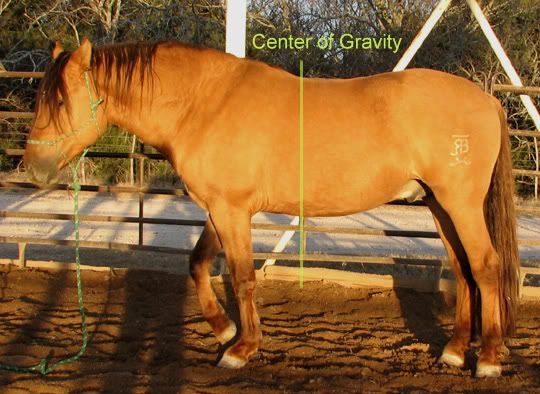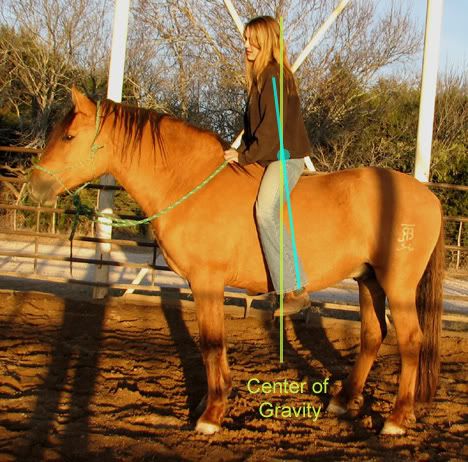|
|
Post by Michelle Clarke on May 10, 2012 7:37:34 GMT -5
Something to think about this morning... Here is a pict of this horses center of gravity as he stands:  Here is the rider sitting in a position that many western rider take:  Here is the rider in position that many english riders take:  The rider is almost balanced here...she is slumping however with her upper body:  Ideally, the blue line should be straight with the legs underneath the rider and the upper body over the center of the core. |
|
|
|
Post by DianneC on May 10, 2012 8:15:40 GMT -5
?michelle, could you give us the person you get your halters and leads from? The are hard to find out here. Thanks. This is great, so glad you're doing this.
|
|
|
|
Post by gotkiger on May 10, 2012 10:09:21 GMT -5
I have three different rope haters and a nylon halter. I only use the rope halters now because they fit every horse and I seem to get more control and respect out of them. I will go out and take a picture of my halters in a few min after the baby eats breakfast. I have two leads that are ten feet or more but I will measure to make sure. You are the first to say my stirrups are too short and I will lengthen them for the next time I ride and lose the spurs. Dollie gets lazy and doesn't listen so I started to wear them even though I hate them.
Kind of a side bar on me and my body while riding. I have had three ankle surgeries and need at least two more (shortening and tightening the tendons that stretch from the knee to the ankle). Because of that I have a tendency to ride on my toes and I don't have a lot of strength in my lower leg. I can grip with my upper leg and my knees like no other but my lower legs are very weak.
|
|
zhiaral
Weanling
  Dusk & Dam
Dusk & Dam
Posts: 82 
|
Post by zhiaral on May 10, 2012 10:15:59 GMT -5
I've always used nylon halters. I've seen the rope halters, of course, but I didn't know they made much of any difference other than cosmetic - all of the people I've known to use them chose them purely for cosmetics. I'll have to get Dusk one, if I can find it in her size! She's already wearing a small horse halter instead of a yearling, because her face is so long in the bones. This thread is already fascinating to read.
|
|
|
|
Post by gotkiger on May 10, 2012 11:49:18 GMT -5
Dollie With nothing on  Side View of her halter, two knot rope halter  Front View of her halter  Side view of the four knot rope halter I have  Front View of the four knot rope halter  Side view of the halter I use for Frodo. Wrapped nose band with a twist  Front View of Frodos halter. Wrapped nose band with a twist  |
|
|
|
Post by gotkiger on May 10, 2012 11:52:05 GMT -5
oh I have two leads, blue and black.
the blue is 12 foot, and the black is 10 foot
|
|
|
|
Post by Michelle Clarke on May 10, 2012 12:07:29 GMT -5
The first one fits her the best; the four knot is for horses that pull and the twist is for a real hard head. My guess is the last two are too harsh for her. We may be able to use the four knot one if she gets into mode of arguing by pulling but mostly lets use the plain one. I don't like snaps because they break, because they are heavy and they can be harsh when doing groundwork. You can take the snap off the blue one for now and put it on the top halter. I do need to get you a longer lead - we use 15'. It takes some getting used to the length but as we go along you'll be glad for the extra footage.
I got a short video done with haltering and mounting before we had a downpour, so I'll get that uploaded to share.
|
|
|
|
Post by gotkiger on May 10, 2012 12:32:30 GMT -5
I have a 20 foot cotton lunge line that I have tied knots in do it won't run through my hands. But it has a small clip. I am goin out tomorrow sovi can look for a longer rope without a clip. I like the long ropes you an do a lot with them. As far as halters go I only use the first one on Dollie. I don't like the seccond at all. It just sits in my tack shed gathering dust. The third is Frodos, it was that or a nylon halter with a stud chain (per the landlords order not because he needs it)
|
|
|
|
Post by Michelle Clarke on May 10, 2012 12:50:10 GMT -5
The cotton lunge will be too light. We use the yacht rope because it carries energy well and quits having energy when you do. I'll send you one.
As far as your riding - you are probably ahead of the game because 1) I don't want your heels down (so no stress on your leg) and 2) your lower leg needs to be loose at all times, even when you are aiding and 3) you never need to grip to ride anywhere.
The longer stirrups will help your legs and also you might look at the slanted stirrups. Lynn, who is on this board, is at our place and she has had major injuries from a car accident. Her ankle is basically fused. These stirrups allow her to rider correctly and pain free.
Dianne - we have a gal here that makes them for us. Just let me know what you want, she only sends them here.
|
|
|
|
Post by gotkiger on May 10, 2012 13:17:32 GMT -5
Can you get a picture of the slanted stirrups? They sound interesting.
I grew up riding bareback with and without a pad on a racing qtr bred mare. We would go "flying" around the arena ( just cantering but it always made me feel free and like I was flying). I would also run barrels on her bareback. She would crow hop and spin and do some other things that would normally unseat someone and somehow I managed to stay on. I guess that is where I learned to grip and why to grip.
Also this isn't my normal saddle. I normally use an Aussie saddle but I had a stirrup break so I am waiting for a replacement. I know Aussies aren't the best for kigers and that this western is probably better but the fenders on the western tend to hurt my knees.
|
|
|
|
Post by stormyranch on May 10, 2012 21:02:54 GMT -5
i'M LOVNG this thread :-)!!!!
|
|
|
|
Post by Michelle Clarke on May 11, 2012 20:29:32 GMT -5
|
|
|
|
Post by Michelle Clarke on May 11, 2012 21:26:13 GMT -5
Haltering Video:
[youtube]http://www.youtube.com/watch?v=5ybgQibZBeU&feature=g-upl
[/youtube]
You want the halter to sit further up the face, not on the thin part of the nose. The lower it sits, the harsher it can be. The halter also needs to be behind the jaw for a proper fit, especially if you are working on tying so the pressure is applied on the poll and under the jaw; not just the poll.
As you can see, the knot is tied underneath where it comes into the loop and above the loop knot. If it is tied above the loop - it can easily come loose. If the tail of the halter is long, I tuck it into the jaw piece so it does not swing up into their eye as they move.
|
|
|
|
Post by Michelle Clarke on May 11, 2012 21:53:27 GMT -5
Mounting and dismounting:
Callie first squares Reina up in the front - mainly because when we show, she has to be square for the Versatility mounting. We also used a small step because I don't want to drag that little saddle across her withers or tighten it too much so it does not move. Notice Callie lets her have some rein but not too much because if she moves off, Callie can pick up on her without fumbling around.
Callie has the rein and mane in her left hand - her right hand is on the front of the saddle. This keeps all your weight over the horses' center of gravity. She gently rocks Reina back and forth so Reina prepares to be mounted and steadies herself.
Callie steps up, lays her hip facing forward against the saddle...this is safe because if Reina where to move and Callie had to step down for any reason, she could do so quickly and in balance. If Callie was laid across the saddle with her hips pointed over Reinas' back - she would be in a poor position to get down safely.
Callie leans over to Reinas' right side, makes eye contact with the right eye and pets her on the neck and also on the rump. This again, makes sure the horse knows your intentions plus prepares them in case your foot where to brush their hip as you go over. After making sure the horse is not going anywhere, Callie swings over gently sitting in the saddle. She'll reach down and place her foot in the right stirrup instead of bouncing her foot around searching for it. This is for training purposes. You not only want the horse to be patient and wait to be asked to move but if you are on a young horse or one that feels the need to leave, this does not give them a reason to do so.
Dismounting is basically the same thing backwards - once stopped, gently rock the horse back and forth to steady themselves. Have the rein and mane in the left hand, swing your right leg over, hesitate, then gently step down.
|
|
|
|
Post by Michelle Clarke on May 11, 2012 21:56:48 GMT -5
I've got some groundwork stuff done and will get that edited and uploaded tomorrow...
|
|